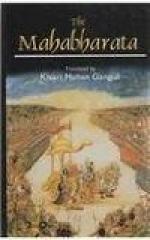“Bhishma said, ’Having enquired into the conduct and disposition of the person, his learning and acquirements, his birth, and his acts, good people should then bestow their daughter upon accomplished bridegrooms. All righteous Brahmanas, O Yudhishthira, act in this way (in the matter of the bestowal of their daughters). This is known as the Brahma marriage, O Yudhishthira! Selecting an eligible bridegroom, the father of the girl should cause him to marry his daughter, having, by presents of diverse kinds, induced the bridegroom to that act. This form of marriage constitutes the eternal practice of all good Kshatriyas. When the father of the girl’, disregarding his own wishes, bestows his daughter upon a person whom the daughter likes and who reciprocates the girl’s sentiments, the form of marriage, O Yudhishthira, is called Gandharva by those that are conversant with the Vedas. The wise have said this, O king, to be the practice of the Asuras, viz., wedding a girl after purchasing her at a high cost and after gratifying the cupidity of her kinsmen. Slaying and cutting off the heads of weeping kinsmen, the bridegroom sometimes forcibly takes away the girl he would wed. Such wedding, O son, is called by the name of Rakshasa. Of these five (the Brahma, the Kshatra, the Gandharva, the Asura, and the Rakshasa), three are righteous, O Yudhishthira, and two are unrighteous. The Paisacha and the Asura forms should never be resorted to.[277] The Brahma, Kshatra, and Gandharva forms are righteous, O prince of men! Pure or mixed, these forms should be resorted to, without doubt. A Brahmana can take three wives. A Kshatriya can take two wives. As regards the Vaisya, he should take a wife from only his own order. The children born of these wives should all be regarded as equal.[278] Of the three wives of a Brahmana, she taken from his own order should be regarded as the foremost. Similarly, of the two wives permitted to the Kshatriya, she taken from his own order should be regarded as superior. Some say that persons belonging to the three higher orders may take, only for purposes of enjoyment (and not for those of virtue), wives from the lowest or the Sudra order. Others, however, forbid the practice.
The righteous condemn the practice of begetting issue upon Sudra women. A Brahmana, by begetting children upon a Sudra woman, incurs the liability of performing an expiation. A person of thirty years of age should wed a girl of ten years of age called a Nagnika.[279] Or, a person of one and twenty years of age should wed a girl of seven years of age. That girl who has no brother nor father should not be wed, O chief of Bharata’s race, for she may be intended as Putrika of her sire.[280] After the appearance of puberty, the girl (if not married) should wait for three years. On the fourth year, she should look for a husband herself (without waiting any longer for her kinsmen to select one for her). The offspring of such a girl do not lose their respectability, nor does union with such a girl become disgraceful. If, instead of selecting a husband for herself, she acts otherwise, she incurs the reproach of Prajapati herself. One should wed that girl who is not a Sapinda of one’s mother or of the same Gotra with one’s father. Even this is the usage (consistent with the sacred law) which Manu has declared.’[281]




